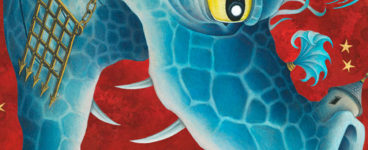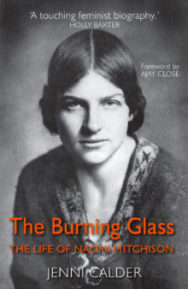‘She was a remarkable woman whose impact on Britain’s social and cultural scene was considerable. She is a striking example of the way an individual with courage and determination can use privilege for positive ends. But she would be the first to say that today, perhaps more than ever, there is a need to support those without a voice.’
Naomi Mitchison was a force of nature, and BooksfromScotland is delighted to see a new edition of Jenni Calder’s biography of this amazing writer and woman. Carla Sassi discovers that this is a biography that shall surely herald a new generation of fans.
The Burning Glass: The Life of Naomi Mitchison
By Jenni Calder
Published by Sandstone Press
‘To understand just one life you have to swallow the world’ says Saleem Sinai, the narrator of Salman Rushdie’s novel Midnight’s Children. If this is true of any life, it applies even more so to that, extraordinarily long and rich, of Naomi Mitchison (née Haldane 1897 –1999) — a life that literally, and not just metaphorically, embraced the whole planet, well beyond her native Scotland and her second, equally loved adoptive home, Botswana. A polymath, an avid traveller, a Scottish nationalist, a socialist, an aristocratic cosmopolitan, a feminist, a most prolific writer, an outspoken advocate for those who were oppressed and silenced (‘the people who have not spoken yet’), Mitchison was a free spirit — generous, brave, relentless and indomitable. She championed the local, but always in the name of a universal vision of social justice. She came from an exceptionally privileged background, both socially and culturally, but she felt in many ways more at home with the Highland fishermen and the Bakgatla tribesmen of Botswana. A writer of historical novels often set in the ancient past, she was also an attentive recorder of her own time and life, leaving behind a wealth of journals, diaries, letters, sketches and three autobiographical volumes. To bridle such complexity one is tempted to borrow Muriel Spark’s concept — the quintessentially Edinburgh ‘nevertheless’ that can ineffably and effectively bridge the most incompatible of opposites. ‘I find that much of my literary composition is based on the nevertheless idea. I act upon it,’ said Spark in her essay ‘What Images Return.’ An Edwardian child, Mitchison lacked Spark’s postmodern irony, but she could have easily identified with her younger colleague’s transcending of conventional binaries through ‘action’ — by ‘performing’ conflicts in her own writing and life she made continuous and compatible stances and experiences that for many were irreconcilable. To engage in the writing of the biography of such a charismatic and kaleidoscopic figure, when she was still alive and vigilant, and very much in control of the narrative of her life, must have been an extraordinarily daunting task even for Jenni Calder — herself an established writer, a distinguished scholar and in a relationship of friendship and familiarity with her subject.
First published by Virago Press in 1997, only two years before Mitchison’s death (at the age of 101), Calder’s biography is a remarkable tour de force — embracing the complexity of its subject and going a long way to doing justice to her multifaceted career. Originally titled The Nine Lives of Naomi Mitchison (a title that, after reading the biography, is bound to sound more an understatement than an exaggeration), this is a most thorough and thoughtful work, comparing and balancing out Calder’s research with Mitchison’s comments and memories as they surfaced in the conversations with her biographer and emerge from a vast corpus of autobiographical writings. Calder’s admiration for her subject is (understandably) strong, but not unconditional, as she goes a long way to pinpoint the grey areas that characterised Mitchison’s endeavours and experiences by discreetly letting them emerge and define by themselves, without pointing her finger at them. From Mitchison’s intellectual and competitive bond with her brother Jack, to her affectionate but controlling and possessive relationship with Linchwe, the Bakgatla chieftain whose friendship introduced her to Africa, the reader is provided with numberless cues as to the many tensions and contradictions that animated Mitchison’s long life.
There other features that make this biography remarkable, and they all have to do with Calder’s approach to her task. Accurate and painstakingly researched, The Burning Glass, aims at memorialising an extraordinary writer and intellectual in the most possible ‘objective’ way, but also at discreetly acknowledging and recording that complex bond that ties any biographer to his/her subject. This is most obvious in the last section of the biography — chapter 9 (‘Personal and political’) — where the process underlying the writing a life subtly takes centre-stage, and where the lives of Calder and Mitchison intersect and reveal more than accidental similarities and parallelisms. A bond made of affinity and mutual understanding unfolds from their first chance encounter on a flight from Nairobi to London in 1970, to the many visits Calder paid to Mitchison at her Carradale ‘ancestral’ home when working on her biography. ‘By this time’, Calder recalls ‘I had become part of the story I was going to tell’. As the notes she took in the course of those visits are woven into the story of Mitchison’s life, Calder becomes aware that ‘the biographer of a living and co-operative subject cannot avoid stepping on to the stage’ — ‘I was a character as well as audience’ she explains (p. 379).
The revised edition published by Sandstones has a new (more convincing) title, and a new epigraph — ‘For intensity there must be: a focus, a burning glass, a painful shaping’ — both borrowed from Mitchison’s essay ‘Poets and Prophets’ in What the Human Race is Up To (1962). Very much in line with her approach to biography writing, Calder lets Mitchison ‘speak for herself’ and selects from her writings a single image — conflating intensity with burning passion — to provide a unifying perspective on her tumultuous existence. There are other (minor) adjustments and corrections, and there is a thoughtful foreword by Scottish-based writer Ajay Close, but on the whole The Burning Glass does not represent a radical departure from the first edition. For those of us who enjoyed the 1997 edition, it is certainly worthwhile, after almost 20 years, to go back to it, and re-discover both Mitchison’s legacy and the subtle art of Calder. For those who know little (or nothing) about Mitchison, Calder’s biography represents no doubt the best starting point for a journey of discovery.
The Burning Glass: The Life of Naomi Mitchison by Jenni Calder is published by Sandstone Press, priced £9.99
ALSO IN THIS ISSUE

 The Honours of Scotland
The Honours of Scotland
‘Hidden, stolen, mended, remade – these precious objects, along with the Stone of Destiny, now take …

 An Illustrated Treasury of Scottish Castle Legends
An Illustrated Treasury of Scottish Castle Legends
‘Fear not the Dark Dragon of Dunvegan. If it should ever awake from sleep.’













